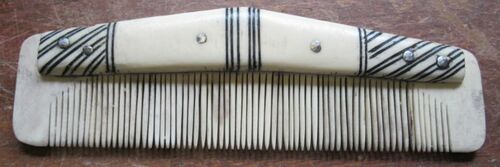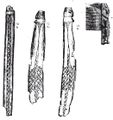More Crafts pages
Intro here
Typology
We are using Steven Ashby's Typology.
Ashby Type 1a - Early Anglo-Saxon
Date: AD300-600
Mainly found in: England, Netherlands, Belgium, Denmark
Ashby Type 1b - Barred
Date: AD500-800
Mainly found in: England, Netherlands, Belgium, France
Ashby Type 1c - High-backed
Date: AD450-800
Mainly found in: Scotland, Ireland
Type 2a - Flat-sided
Date: AD600-900
Mainly found in: England, Netherlands, Belgium, France
The flat connecting plates are cut from the ribs of sheep or other domestic mammals
Type 2b - Bowed
Date: AD600-900
Mainly found in: England, Netherlands, Belgium, France
Frequently referred to as 'hogback' or 'winged' combs.
Type 2c - Coped
Date: AD600-900
Mainly found in: England, Netherlands, Belgium
They are most common in the Netherlands, but also appear in small numbers in the southern British Isles.
Replica by Gavin Archer - England, York: Coppergate
|
Type 3 - Handled
Date: AD700-1100
Mainly found in: England, Netherlands, Belgium
Southern Style use a slotted antler tine.
Northern Style consists of 2 connecting plates.









